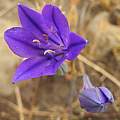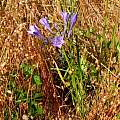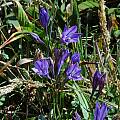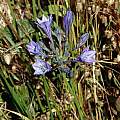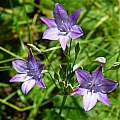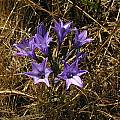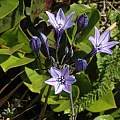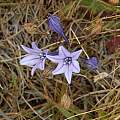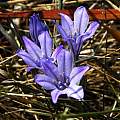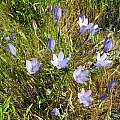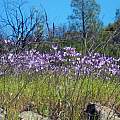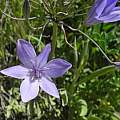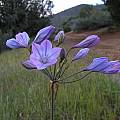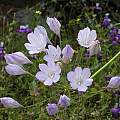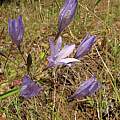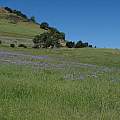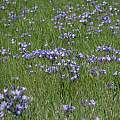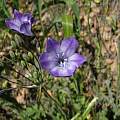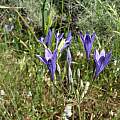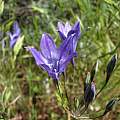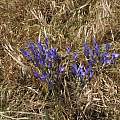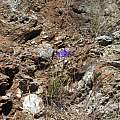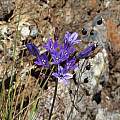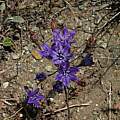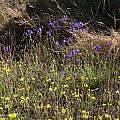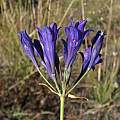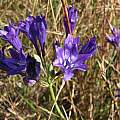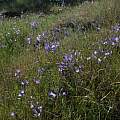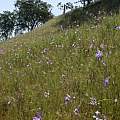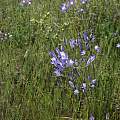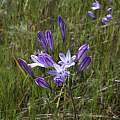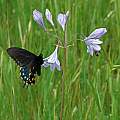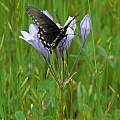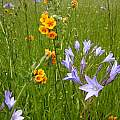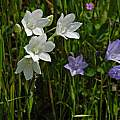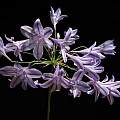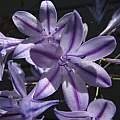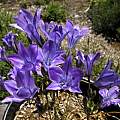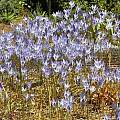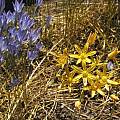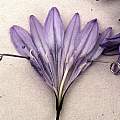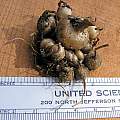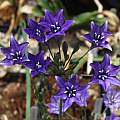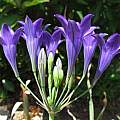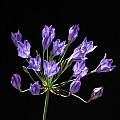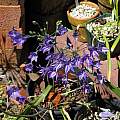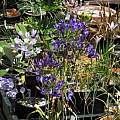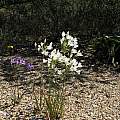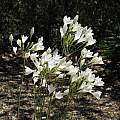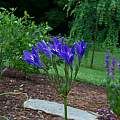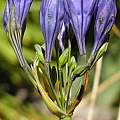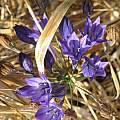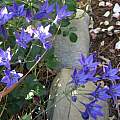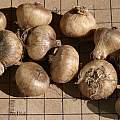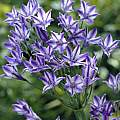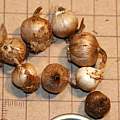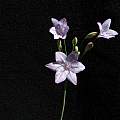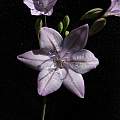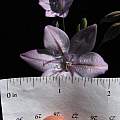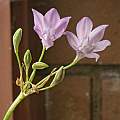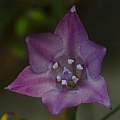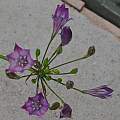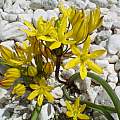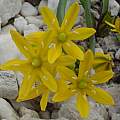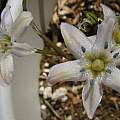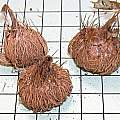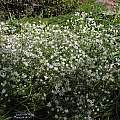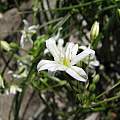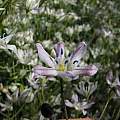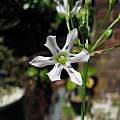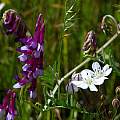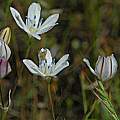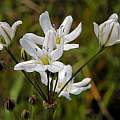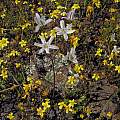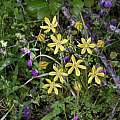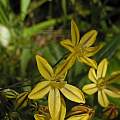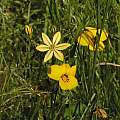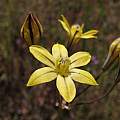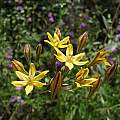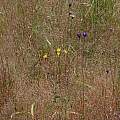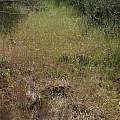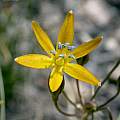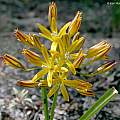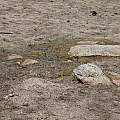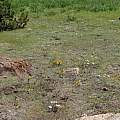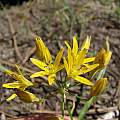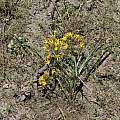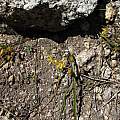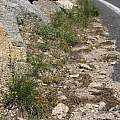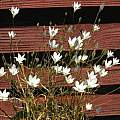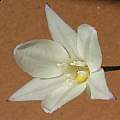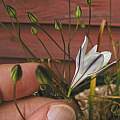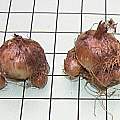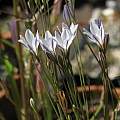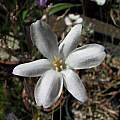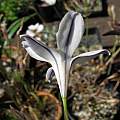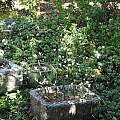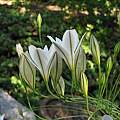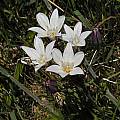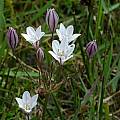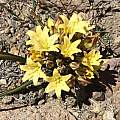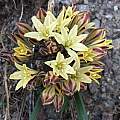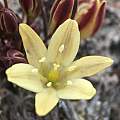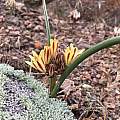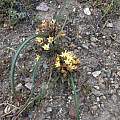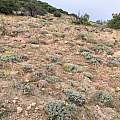Triteleia species j-z are featured on this wiki page.
Triteleia Hybrids — Triteleia a-g — Triteleia h-i — Triteleia index
Triteleia laxa Benth. is found between 0 and 4600 feet (0 to 1500 meters) in a variety of habitats such as mixed evergreen forests, grassland, foothill woodland, and chaparral throughout much of California and into Oregon. Flowering often begins as the foliage dies back, but to some degree this depends on the weather and the original source of the form. There is much variation in color and form and time of bloom (April to July in the wild). The funnel-shaped flowers vary considerably in color (from blue, to violet and purple, occasionally white) and size in different habitats. Linear filaments are attached at different levels. Anthers are white to blue. The ovary and style are hidden from view. Some forms offset heavily and others do not, but just produce bigger corms and more flowers over time.
Photos below were taken in Mendocino County, California by Mary Sue Ittner and Bob Rutemoeller near the Pacific Ocean and the last one near the Gualala River in a more sheltered location.
Photos below were taken mostly at Salt Point State Park in Sonoma County by by Mary Sue Ittner and Bob Rutemoeller.
Photos 1-6 are of habitat shots taken in three different counties. Photos #1-3 were taken near Bear Valley Road, Colusa County. Photo 4 is a mountain form with large flowers seen in Kern County. Photo #5 is a form with light colored flowers growing with Collinsia in Mariposa County. Photos 1-5 were taken by Mary Sue Ittner. Photo 6 by Nhu Nguyen was taken in Napa County.
The photos below were taken at the north entrance to Mount Diablo State Park, Contra Costa County, CA. This area gets a somewhat mild winter and a very warm summer. Photos 1-2 shows the largest mass blooming of this species I have ever seen! This blooming occurred only once during a year with very good winter rain prior to the spring blooming. The other photos show plants growing at the foot of Mt. Diablo. Photos by Nhu Nguyen.
The photos below were taken in various locations in Marin County, CA, by the ocean. These plants grow on well-drained soils, sometimes on serpentine. These deep and beautiful purple forms can also be found on the San Francisco peninsula. Photos by Nhu Nguyen.
The photos below were taken in Calaveras County, CA, in the foot-hills of the Sierra Nevada. This area gets a scorching summer and a cold, sometimes snowy, winter. Photos by Nhu Nguyen.
The first three pictures were taken in Tehama County, near Vina, California in April 2006. Black Pipevine Swallowtails and honeybees were pollinating the flowers. Photos by Bob Rutemoeller.
The photos below were taken of forms from Butte County, CA. Photo 1 was taken by Mary Sue Ittner at Bidwell Park in Chico and shows a rare white flower next to the normal blue flowers. Photos 2-3 were taken by Nhu Nguyen of a nice Butte County selection from Telos Rare Bulbs.
Photo 1 taken by Bob Rutemoeller shows a plant grown from wild collected seed sold by Ron Ratko. Photo 2 is of a lighter form that was planted in a raised bed for about 12 years and increased well. This raised bed received no water in summer and was rarely fertilized. This species also looks good planted with Bloomeria crocea which blooms at about the same time. Photos 3 illustrates them growing together. Photo 4 was taken by Richard Haard showing a dissected flower. Photo 5 taken by Mary Sue Ittner is a photo of the corms of a form that multiples very rapidly.
The photos below are of plants in cultivation. Photos 1-2 are of plants grown from seeds collected in Marin County, CA. Photos 3-5 are of a nice form purchased from the Tilden Botanical Garden. Photos by Nhu Nguyen.
The photos below are of a white form of the species from the UC Botanical Garden. Photos by Nhu Nguyen.
Triteleia laxa 'Humboldt Star' is a wild selection by Jim Robinett from seeds collected in Humboldt county (California) at 2400 feet in full sun. Unlike most forms of T. laxa, these bulbs simply become huge rather than producing many offsets. Blooms in early summer. Photo of a garden plant by Mark McDonough, 2002.
Triteleia laxa 'Queen Fabiola' blooms reliably each year in full sun or dappled shade garden beds. Photos 1-3 June 2007 and corms on a 1 cm grid in 2011 by M. Gastil-Buhl.
Triteleia laxa 'Rudy Kleiner' discovered by Boltha in the Netherlands. It probably was just a seedling that was striking. Flower photo by Jan van den Berg. Photo of corms on a 1 cm grid by M. Gastil-Buhl. Photos 3 and 4 of plants in cultivation in California by Richard Sullivan
Triteleia laxa 'Sierra Giant' is a form available to gardeners from Telos Rare Bulbs. It is suggested to be a polyploid (chromosomal duplication), which often results in gigantism. The 6" diameter inflorescence is held up by a ~20" peduncle. Grown and photographed by Nhu Nguyen
Triteleia laxa '4U' is a commercially available selection with pink tinted flowers. Photos by David Pilling.
Triteleia lemmonae (S.Watson) Greene is a species that is endemic to Arizona where it grows in sparse pine woodland at elevations between 5000 and 7000 feet (1524-2134 meters). It has bright yellow flowers fading purplish with arrowhead-shaped anthers. These plants were raised from seed collected by Southwest Native Seeds and are flowering in late spring in Tasmania. Grown and photographed by Rob Hamilton.
Triteleia lilacina Greene is found on the volcanic tablelands in the northern and central Sierra foothills of California between 229-492 feet (70-150 meters). It has small flowers with an inner surface of glassy shine from tiny glass like beads. It has folded petal edges, which make its tips appear pointed, purple anthers, and a yellow green ovary. It blooms April to May. This species has very distinctive corms. Photo 1 by Bob Rutemoeller and photo 2 by Mary Sue Ittner shows corms on a 1 cm square grid. Photos 3-6 were taken by Nhu Nguyen. Photos 3-5 were taken at the Tilden Botanic Garden showing a bed full of plants and a purple variant. Photo 6 shows the purple anthers.
The first three pictures below taken by Mary Sue Ittner show some wild populations of this species in the native area of Bidwell Park in Chico, California. Pictures show it growing next to an unknown vetch, being pollinated, and a close-up of the umbel. The last shows it growing on the very thin soils of Table Mountain in Butte County surrounded by annuals. Photo by Bob Rutemoeller.
Triteleia lugens Greene commonly known as Coast Range Triteleia is found in dry, sunny to partially shaded, clayey, forested or brushy places between 328-3280 feet (100-1000 meters). Although rare, it is found in scattered locations in California. Flowers have a funnel shaped tube and are deep to pale yellow, striped dark. The filaments are unequal (1-2 or 2-3 mm), broadly triangular shaped, and are all attached at the same level. The anthers are yellow or blue. Photos 1-3 were taken by Mary Sue Ittner at Pinnacles National Park in April 2005 where it was growing along a shady trail with Collinsia heterophylla and Viola pedunculata.
The photos below were taken by Nhu Nguyen showing the plants, flowers, and habitat of this species found at Pinnacles National Park.
Triteleia montana Hoover is found on gravelly soil on granitic substrate in ridge habitats in open montane forests between 4000 and 9800 feet (1200-3000 meters) in northern to central Sierra Nevada of California. Flowers are spreading, yellow with brown midveins, aging purple with a funnel shaped tube, stamens that are more or less equal and attached at one level. The filaments are linear, more than 1/2 the lobes and the anthers cream to blue. Photos taken by Keir Morse July 9, 2005 in Yosemite National Park and shared here under the CC BY-SA 3.0 license.
The photos below were taken by Nhu Nguyen in Yosemite National Park. These plants can be found in well drained meadows and along roadsides in decayed granite. Photo 2 shows the plants growing with Cistanthe umbellata
Triteleia peduncularis Lindl. occurs along the coast of Northern and Central California from Humboldt to Monterey counties and is usually found in vernally wet habitats such as swales, marshes, and temporary streams. The bowl-shaped flowers are white, often flushed purplish on the outside or with indigo stripes on the back or occasionally pale rose-purple. The ovary is yellow. In the wild this plant blooms from May to July. In the garden in my experience it needs a lot of water late in spring or it will go dormant without blooming. The first photo below shows the widely spaced umbel with each flower held on a long wiry pedicel and the next two photos are close-up. The first three photos by Bob Rutemoeller. The last taken by Mary Sue Ittner shows the corms of a variety that produces a lot of small cormlets around the corm photographed on a 1 cm square grid.
The photos below were taken by Nhu Nguyen of plants in cultivation showing a slightly lilac and a white form. Photos 4-5 were taken at the Tilden Botanic Garden.
Flowering June 2006 in Stornetta Public lands, these plants did not have the very long pedicel which so often is used as a distinguishing characteristic of this species. Photos by Bob Rutemoeller and Mary Sue Ittner showing the yellow ovary and distinctive markings on the back.
Triteleia piutensis E. Kentner & K. Steiner was described in April 2014 and is only known from two populations in the Piute Mountains of the southern Sierra in Kern County, California where it is found in openings in pinyon-juniper woodland on volcanically derived soils. It is similar to Triteleia crocea and has erect, yellow, campanulate flowers with recurved lobes, a short ovary stalk and stamens attached at two different levels. It is currently threatened by wind energy development. Photos from Matt Berger.
Triteleia Hybrids — Triteleia a-g — Triteleia h-i — Triteleia index
